Adding a wholesale component to your business is a great way to expand your income. This post will explore how to start small and build relationships with local businesses as a first step to adding a wholesale revenue stream.

Before jumping into my recommendations, I wanted to share some background and my approach to wholesale. I consider wholesale to be a complement to my work as an illustrator and surface pattern designer, but it’s not my only, or even my primary revenue stream. My wholesale business grew organically from exhibiting at local arts and crafts fairs.
The growth has been steady, but I have chosen to keep it relatively small since it’s not the primary focus of my business. If this sounds like something that would complement your current approach, keep reading for a roadmap to start your own wholesale journey, including some valuable hints and tips I learned along the way.
Start Local
I’m lucky to live in an area with several small towns within an hour drive that are filled with locally owned gift shops, bookstores, nurseries, coffee shops, and other small businesses. Because of this, I’m able to have a wholesale business that is almost entirely local. By staying local, I know all the business owners or buyers personally. Relationships with the shop owners have been invaluable in getting support for my work and feedback on my products.
There are so many amazing reasons to shop local and support local businesses. By selling my products through these businesses, I’m contributing to a thriving local economy. Here are just a few of my favorite reasons to shop and sell local:
- Supporting small businesses creates jobs and helps the local economy by keeping tax dollars in the community.
- Small businesses give back to the community, often sponsoring local youth sports, or making contributions to local schools.
- It’s environmentally friendly, requiring less transportation to ship products and encourages local shopping, which also reduces transportation and resources.
- Local businesses often know the vendors that are featured in their shop, so their product knowledge is much higher than at chain stores.
- Local businesses tend to have better customer service since they are part of the community, and their business depends on their reputation with locals.
- Shopping local offers more variety and diversity of products, offering customers something unique that they can’t get from a big box company.
- Shopping and selling local fosters a sense of community and connection between the vendors, shop owners, and customers.
Now that I’ve convinced you on the benefits of working with local businesses, here are a few tips to get your products carried in their stores.
Identifying Winning Products
Like every other aspect of my business, I’m a big fan of research. Building a wholesale business with local retailers is no different. The good news is, it involves shopping and is actually pretty fun! If you’ve ever pitched your portfolio to a business, the process is similar — researching businesses to find the best fit for your style and product.
Before reaching out to any local retailers, I spent a few afternoons in local downtowns, browsing in local shops. I took note of the types of products that each shop carried. I noted the atmosphere in the shops and the aesthetic of their products. I also paid attention to other customers to see how busy the shops were and how the customers responded to the work in the shop. I paid attention to the staff in each shop and whether they were friendly and outgoing and how they treated the customers.
I didn’t limit myself to just gift shops as there are many businesses that carry small gift types of products. I saw delis that sold tea towels and cocktail napkins, nurseries that sold botanical prints and printed tote bags, bookstores that sold notecards and stickers, as well as more traditional gift shops with a combination of all these things.
After my shopping field trip, I made a list of the shops I liked the most and the products that seemed like the best fit for each shop.
Making Contact
Once you’ve identified the shops you want to target and the products that are the best fit, it’s time to put yourself out there.
Spend some time thinking about your pitch. It doesn’t have to be a full presentation, just a few lines of introduction, saying who you are, what you do, and asking if they’re open to carrying a few new products. Bring some samples of relevant products so you can show your work.
It’s also helpful to mention any personal connections, or work you’ve sold in the area. For example, I had a booth at a local craft fair a couple of years in a row and had an idea of what products sold well to this community. I mentioned this in my pitch to give a sense that I’m part of the community, had some success with the local market, and care about supporting the local businesses.

I started with something like this:
“Hi, my name is Kelly and I’m a local artist. I love your shop and am curious how you select products for your shop. I recently had a lot of success selling X product at a local craft fair and thought some of my things could do well here. I have a few samples if you’d like to see anything.”
I always find leading with questions and trying to learn about their business is the best way to make headway. That way, even if they aren’t interested, you can learn more about how they run their business and the types of products that would interest them in the future.
Here are a few questions I’ve found to be helpful:
- What types of products do well here?
- What types of customers shop here?
- Are there certain times of the year that you look for new products or that you have the most traffic in your shop?
- Are there other products that you’d like to carry, but don’t have yet?
Once you have your pitch and your products together, it’s time to hit the pavement.
Similar to other types of pitching, use your current contacts to make connections. If you already know some local business owners, ask if they know any of the shop owners on your target list and if they would make an introduction.
If you don’t have a personal connection, that’s OK. Just take a deep breath and go for it. I didn’t know any of the business owners who currently carry my products, but I found everyone to be very open and receptive. Some of them weren’t interested in my products, but everyone was friendly and nice. Some of them even referred me to other businesses they thought might be interested in my products.
One other consideration when pitching products… because local businesses appreciate diverse items, most shops won’t carry a product if another nearby retailer also carries it. I’ve been able to work around this by offering a variety of items to different shops, as long as they each have their own unique item. For example, I have products in three shops on the same street: one carries baseball hats and stickers, another carries tote bags and greeting cards, and a third carries art prints and ornaments. I was able to get products in all three by asking questions about each business and understanding what was important to each shop.
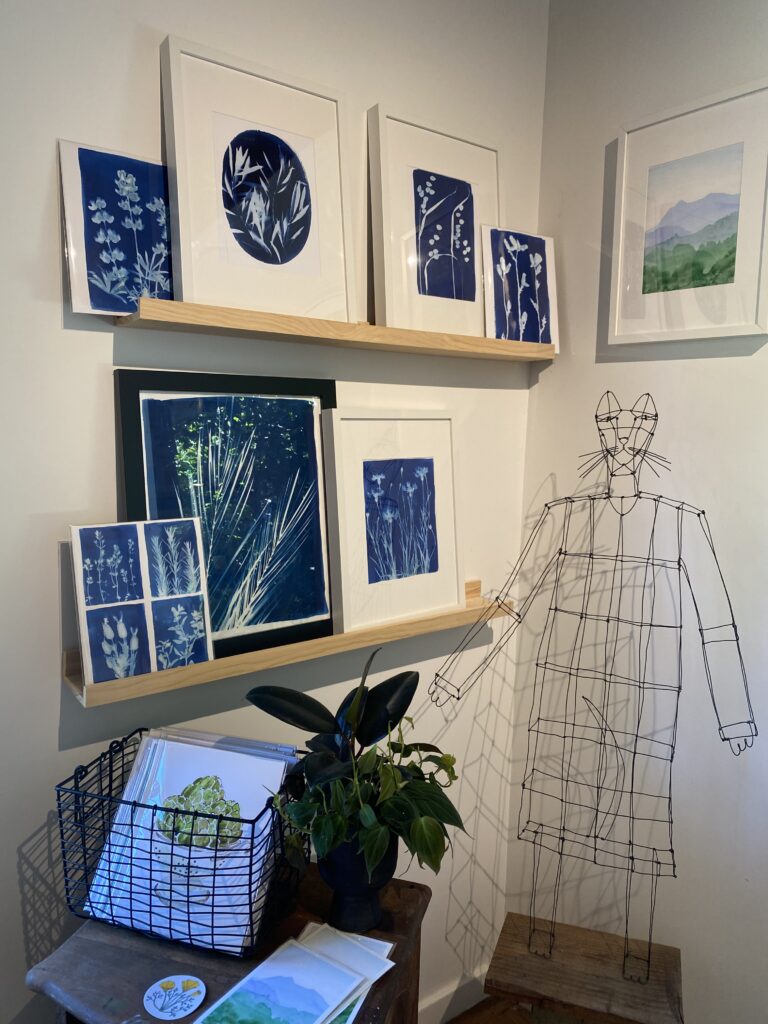
I mentioned above that my wholesale business grew out of my experience at local craft fairs. But that’s not entirely true. I had reached out to a few local stores about a year prior to getting my current customers, without much success. I mention this to share an example of what not to do, as well as to encourage you to not give up if you don’t get traction right away.
I had an introduction to a gift shop owner from a friend who owns a local restaurant. I thought the personal relationship was enough to go and pitch my business, but I hadn’t done any research and didn’t have a clear idea of what I was offering. I didn’t even have a clear idea of what my business was.
I said I could do anything from painting a window display to sell wallpaper, home goods, or greeting cards. The store owner was nice, but a little confused about what I wanted and what I was offering. We had a good conversation, and she gave me a lot of good information, but I realized I was very under-prepared for a successful pitch. Outside of feeling a little foolish and naïve, this was still a positive experience because it helped me hone my pitch and have more success the next time around.
Pricing that Works
In addition to selecting the right products, it’s also important to set the right price.
If you are completely new to retail selling, there are a few terms that are helpful to understand when thinking about pricing.
Cost of Goods or COGS
This is the material cost of an item. If you are making handmade items, it includes things like the cost of paper, paint, clay, fabric, packaging sleeves, or any other materials that are included in the item. If you are printing your art on an item, the COGS include your cost of the item as well as shipping, packaging, or any other materials or costs associated with the procurement of the product.
Wholesale Price
This is the price a retailer will pay you for each product.
Margin
Sometimes known as a mark-up, this is the difference between the COGS and the wholesale price — basically how much you make per item after you subtract your costs. Some people use a percentage of their COGS to calculate their wholesale price, but there is no magic number that you need to hit.
For example, you may also have different margins depending on the item. It might cost you $1.50 to make a card with a wholesale price of $3 (which would be a 100% margin). But a tote bag might cost you $15 and have a wholesale price of $20 (a 25% margin). The tote bag has a smaller margin per item, but you still make $5 per tote bag and only $1.50 for a card, so the smaller margin may be worth it.
Retail Price
This is the price the store will sell the product for. The retail price is generally double the wholesale price. It’s important to keep this in mind when setting your wholesale price because it’s the price the customer will pay, so it should be within the same range of other similar items.
Commission
Sometimes retailers will take products on commission rather than paying for a wholesale order up front. This means they only pay you if the product sells. The commission price is usually 50% of the retail price, which ends up being the same as the wholesale price.
For example, if a retailer sold greeting cards on commission, they would sell the card for $6 and then pay you $3 once the card has sold. This reduces the risk for the retailer because they don’t have to pay you up front before they sell the cards.
I’ve found that some retailers prefer to take new products on commission, but once a product is proven to sell, they will be more willing to commit to larger orders. While not everyone is open to this model, it has been a good way for me to get my foot in the door at more stores.
If you’re unfamiliar with these terms it can be a lot to take in. To illustrate how these work in real life, here’s an example with a 5×7 greeting card:
- COGS: $1.50 (includes the cost of the card, envelope, and clear packaging sleeve)
- Wholesale Price: $3 (the price you get paid for the card)
- Margin/Markup: 50% (the increase between the COGS and the wholesale price)
- Retail Price: $6 (The amount the card sells for in the store)
- Commission: 50% (You would be paid $3 for a $6 card if the commission was 50%)
In this case, it would cost you $1.50 to make the card. The retailer buys the card from you for $3 and sells the card for $6. Your total earning is $1.50.
Production Partners
Finding the right vendor to produce your products is one of the most important decisions you can make. The right partner determines the quality of your products and can have a big impact on your margin. Below are a few factors to consider when choosing a vendor or production partner.
For me, the most important criteria when looking for a production partner is quality. High-quality materials, durability, and color consistency will ensure that your art looks as good as possible and that customers are happy with the end product. To ensure the best quality, it’s important to order product samples.
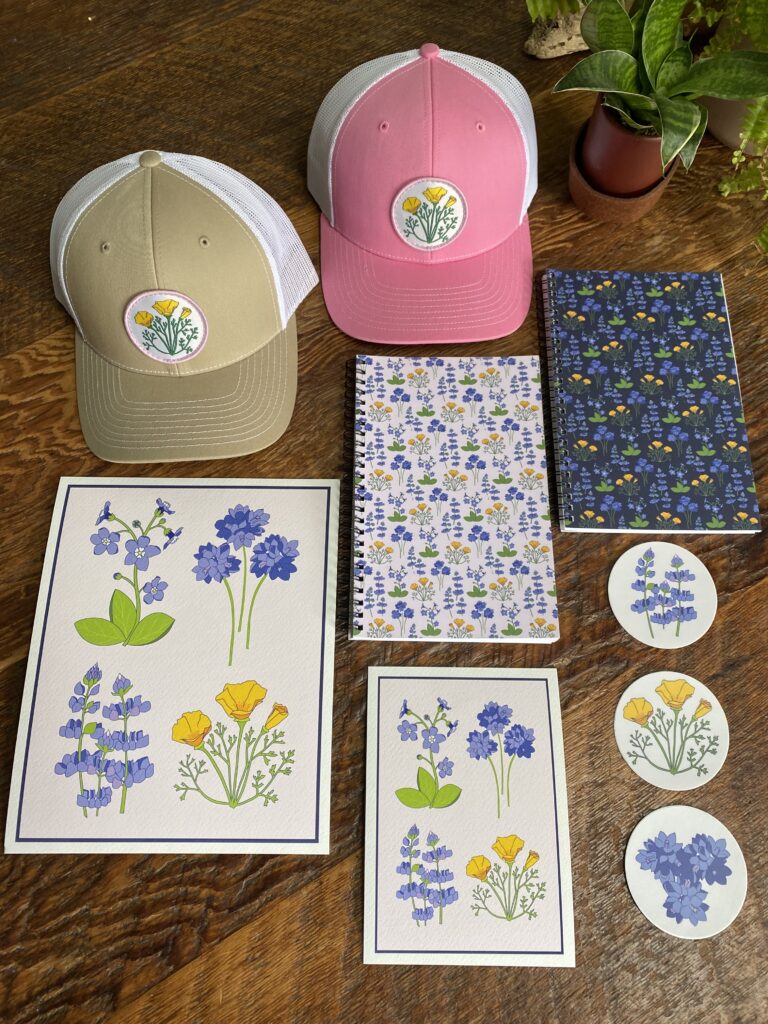
Price is also an important consideration. Ordering larger quantities is one way to get better pricing, but make sure you’ll be able to sell the quantity you order, or you may get stuck with a lot of inventory and sunk costs that you can’t get back. If you have a few channels for your products, this can help. For example, I sell the same products on my website, Etsy, at local craft fairs, and in retail shops. This helps offset the risk when one channel isn’t selling as many products as another.
I’ve learned the hard way to appreciate good customer service. I’ve used vendors that have made printing mistakes and had to order reprints. Being able to easily reach someone and having a responsive customer service team has saved me, especially when I have a tight turn around for an order.
So how do you find vendors that are the right fit for your business?
1. Ask for recommendations
Ask other designers who they use and who they like. If you don’t have any personal connections for people who have made the type of product you want, ask an online community like Sketch Design Repeat!
2. Talk to current customers
Vendors will often have reviews on their websites. If they don’t, ask if they have any current customers you can contact.
3. Order samples
Going through the ordering process will both give you an example of product quality, and the ordering process — how easy they are to communicate with, or how responsive they are if you have issues.
4. Consider companies that make corporate gifts
These companies tend to have better pricing than drop-shipping companies like Society6 and RedBubble and often have great customer service. They can be a little harder to find, since they aren’t consumer facing, so they don’t show up on internet searches, but they are out there. Think outside of your designer network — do you know anyone at a larger corporation who oversees corporate events? They may be a good resource for these types of contacts.
5. Search wholesale marketplaces
You may have heard of Alibaba, a wholesale marketplace that offers many overseas suppliers that manufacture products for much less than American companies. The prices can be much cheaper, but order minimums tend to be higher, lead times are usually longer, shipping costs are high, and quality and customer service may not be as good.
If you have a larger order for a specific product and have long lead times, Alibaba may be a good resource for your business. The marketplace is only as good as the company you’re purchasing from, so like other suppliers, get recommendations from people who have used these suppliers before placing an order.
Related Article: Your First Surface Design Product Line: Manufacturing
Growing your business
I’ve found that when I hit something that works, it tends to expand without much effort. My approach to growing my wholesale business is no different. Once I identified products that sold well in local markets, it was easy to find other shops that were interested. By finding quality vendors and setting the right price point, I’m able to have a steady income with my wholesale products. Below are a few other avenues to consider when you’re ready to expand the wholesale side of your business.
Geographic Expansion
Once a few nearby shops were carrying my products, I started repeating the process with other towns. I used a similar personal approach to the one outlined above, where I researched and introduced myself to shop owners. Through this process, I’ve expanded to two local towns and will be expanding to more in the new year.
While this process has been successful, it is limiting, because it’s so reliant on my time to visit locations and develop relationships. If you’re interested in expanding on a larger scale, you may want to try an online marketplace or trade show to reach more retailers in a shorter amount of time.
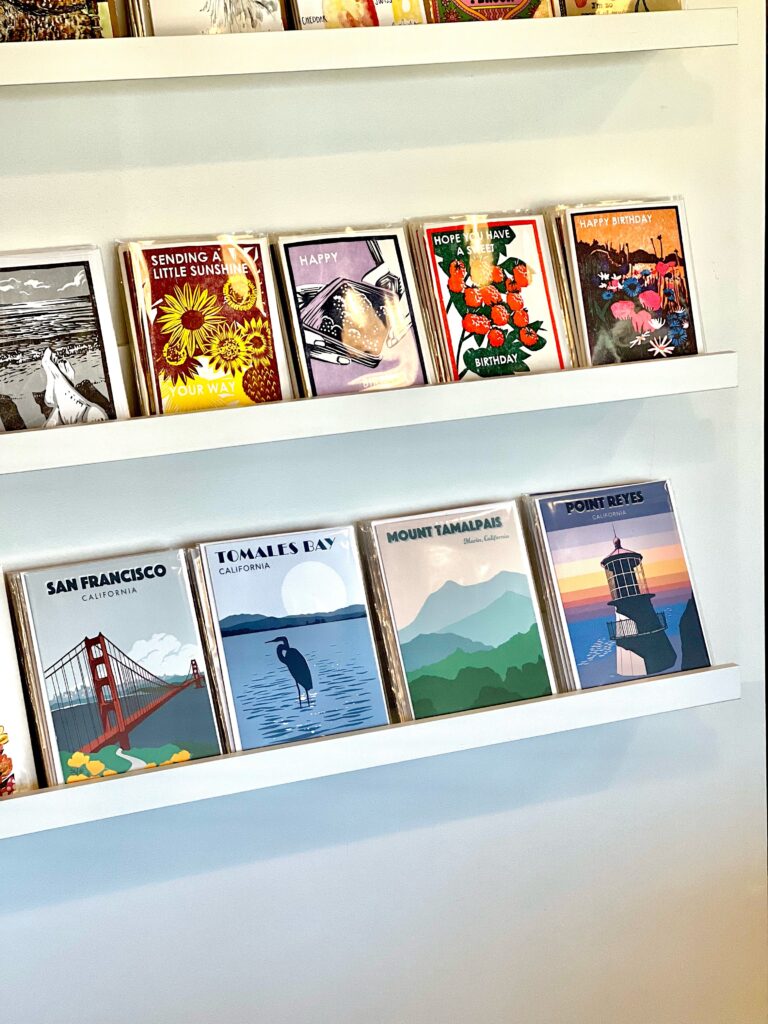
Faire.com
Faire.com is an online wholesale marketplace where retailers can purchase products directly from artists and creators. Faire is similar to Etsy or other creative online marketplaces, but the buyers are retail shops rather than end customers.
Like Etsy, Faire takes a commission on each sale, but provides an online shop and backend that makes selling and managing orders easier. There aren’t many downsides to creating a shop on Faire, but like any ecommerce platform, you must put some effort into marketing so people can find your shop.
Faire has been a nice addition to my wholesale business, but I haven’t put in the effort to grow it as much as I could. However, depending on your business goals, it’s worth exploring as a simple way to expand your customers.
Trade Shows
Another way to get in front of a larger number of gift shop buyers is through a gift trade show. There are several gift and boutique trade shows throughout the US. Most are regional and they happen throughout the year. Exhibiting at a tradeshow would require a whole article of its own! Trade shows can be expensive and labor intensive for small businesses. But once you have a more established wholesale business and are interested in expanding it, trade shows can be a valuable addition to your marketing efforts.
In Summary
Wholesale customers have been a complementary part of my overall business. I have learned what products or pieces resonate with an audience, I get ideas for new products, my art is seen by new audiences, and it occasionally leads to new business, like commissioned works. This focus on slow growth and local markets may not expand as quickly as other approaches, but it’s more authentic to my brand and resonates with the people who carry my work and the customers who buy my art.
I hope my experience will inspire you to explore the world of wholesale as part of your business. If you have any questions, please feel free to reach out! I’d love to hear your experiences as well.
Written by Kelly Miller
Website: www.wildazuredesign.com
Instagram: @wildazure
Kelly Miller is an illustrator, pattern designer and the artist behind Wild Azure Design. Her designs are inspired by the outdoors, travel and a love of adventure. The Wild Azure style is modern, yet playful, incorporating loose expressive watercolor, with hand drawn details.
I’m just starting my wholesale journey, so thanks for all the infos. I also thought about contacting local shops first, so it’s great to see you had success doing the same!
Dear Kelly, your article / experience is indeed inspiring 🙂 Lately I’ve heard from several sources about getting a small line of products into local shops, and I think it could be something for me. Earlier I thought this would be too small and “not scalable” and could not be profitable, but in the meantime I see it like you, something to start with and an opportunity to learn about retailers and end customers. I like the idea of the personal relationships, and also putting something into the world without “gate keepers” (i.e. directly to customers” :))